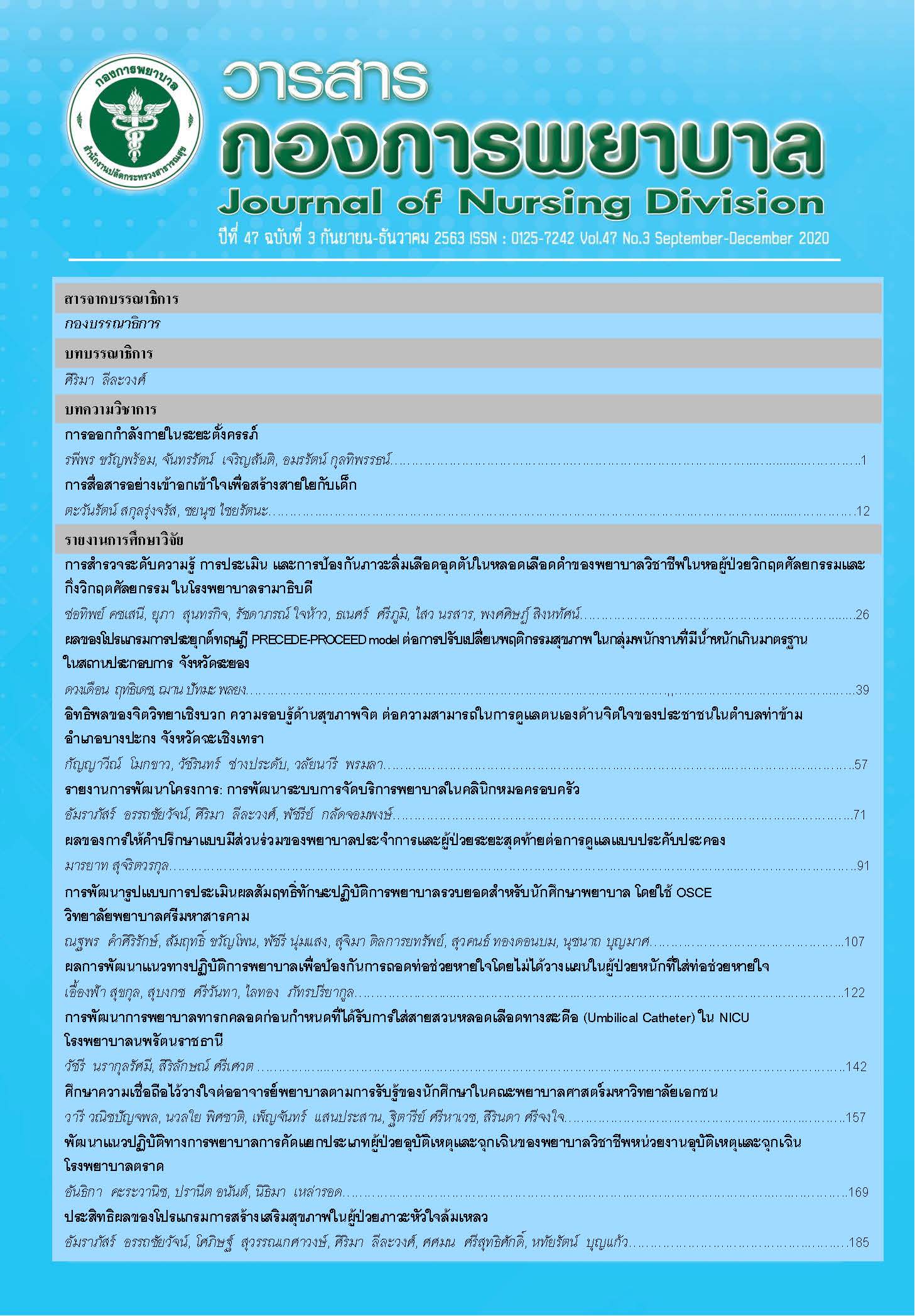The Effect of Utilizing Clinical Nursing Practice Guideline for Prevention Incidence of Unplanned Extubation in Critically Ill Patients
Main Article Content
Abstract
The purposes of this research and development were to develop the practice guideline and investigate the effect of utilizing nursing practice guideline on the incidence rate of unplanned extubation (UE) in patients with ventilator. CURN model was used as a conceptual framework for the development. The samples were selected by purposive sampling and assigned into two groups; 1)The 33 registered nurses in intensive care unit, and 2) The 90 patients with ventilation in intensive care unit. The patients were divided into two groups, The 45 patients after development group from June to September 2020. The 45 patients before development group was selected from the medical records of the patients from May to August 2019. The instrument used was nursing practice guideline for prevention incidence of unplanned extubation. Data were collected from a record of basic data, the UE incidence record, nurses’ knowledge before and after development, and nurses’ opinion. Data were analyzed using descriptive statistics, Wilcoxon Signed Rank test, Fisher’s exact test and Mann-Whitney U test.
The result revealed that the test scores on nurses’ knowledge after development were significantly increase (p<.001). The nurses’s satisfaction was at a high level. The incidence rate of UE in the after-development group was significantly lower than that of the before development group (p < .05). Weaning times with ventilator in the after-development group was significantly lower than that of the before development group (p < .05). The day of ventilator in the after-development group was significantly lower than that of the before development group (p < .05). The study suggests that the nursing practice guideline should be applied in caring for the critically ill patients to prevent incidence of unplanned extubation. Further study should be conducted to clarify the effectiveness in other areas.
Article Details
References
care units: A 15- year experience. Med (Baltimore). 2017;96(27).
2. Selvan K, Edriss H, Sigler M, &Tseng J. Self- extubation in ICU patients. SWRCCC. 2014;2(8):31–34.
3. Lee TW, Hong JW, Yoo JW & et at all. Unplanned Extubation in Patients with Mechanical Ventilation: Experience in the Medical Intensive Care Unit of a Single
Tertiary Hospital. Tuberc Respir Dis (Seoul). 2015;78(4):336-40.
4. Supian Pokathip , Patcharawan Salakkhun, Tisakorn Suttiprapa, Phitchayada Datawee, Prapasson Kwanchang, Nadanong Sanaphrom. Prevalence risk factor
and nursing care of unplanned extubation: An Integrative review. J Health Sci BCNSP. 2019;3(3):53-67. Thai.
5. Wiparat Navarat, Panomporn Prittipongpun, Parichat Srianurak, Patumporn Kanyakamin, Suweena Bohplian. Effect of PMK unplanned extubation prevention
program on extubation rate in medication wards, J Royal JThai Army Nurses. 2017;18(1), 167-175. Thai.
6. Somporn Narakhun, Rachanee Namjuntra, Varin Binhosen . The effect of nursing care protocol on the incidence rate of unplanned extubation in patients with
endotracheal intubation, Thai JCar-ThoN. 2016;27(1):72-84. Thai.
7. Cosentino C, Fama M, Foa C, Bromuri G, Giannini S, Saraceno M, et al. Unplanned extubation in Intensive Care Unit: evidences for risk factor. A literature
review. Acta Biomed. 2017;88:55-65.
8. Prithwis B, Arpan C, Pawan A. Comparison of outcome Of self - extubation and accidental extubation in ICU. Ind JCC Med. 2007;11(3):105-8.
9. Bandura A. Self-efficacy: the exercise of control. New York: W.H. Freeman and Company; 1997.
10. Sessler CN, Gosnell MS, Grap MJ,et al. The Richmond Agitation-Sedation Scale: validity and reliability in adult intensive care unit patients. Am J Respir Crit Care
Med. 2002 Nov 15;166(10):1338-44. doi: 10.1164/rccm.2107138. PMID: 12421743.
11. Thongplew Kunurai, Amporn Namwongprom, Manaporn Chartchumni, Unchalee Yongyuth. Effect of nursing care protocol on incidence of unplanned
extubation in patients with endotracheal tube. J NAT Ned. 2011;29(2):25-33. Thai.
12. Somchit Saengsri . Development of nursing practice guideline for unplanned extubation prevention in surgical intensive care unit. 12th Re Med J.
2012;23(1):54-9. Thai.
13. Maneenuch Suttason, Kanittha Kaewkullaya, Wassana Naiyapatana. Effects utilizing clinical nursing practice guideline on the incidence of unplanned
extubation in critically ill patients. J Nurs Edu. 2017;10(2):58-67. Thai.
14. Bangaorn Nakrit, Ampaporn Navongprom, Nam-oy Pakdevong. Unplanned extubation and duration of mechanical ventilation in critically ill patients on
evidence based nursing practice. KK J Nurs. 2015;22(1):129-43. Thai.
15. Annop Piriyapatsorm, Kaweesak Chittawatanarat, Suneerat Kongsayreepong, Onuma Chaiwat. Incidence and Risk factor of Unplanned Extubation in Critically
III Surgical Patients : The Multi-center hai University-base Surgical Intensive Care Units Study (THAI –SICU Study). J Med Assoc Thai. 2016;99:153-62. Thai.
16. Tanios M, Epstein S, Grzeskowiak M, Nguyen M, Park H, Leo J. Influence of sedation strategies extubation in a mixed intensive care unit. J Cri Care.
2014;23:306-15.
17. Tarntip Wisettharn, Kunjana Pukkham , Somjit Yodrabum . The development of ventilator weaning model in critically ill surgical patients in Maharaj Nakhon Si
Thammarat Hospital. Thai J Car-ThoN. 2019;30(2):176-92. Thai.
18. Kiekkas P, Aretha D, Panteli E, Baltopoulos G & Filos KS. Unplanned extubation in critically ill adults: critical review. Nurs Crit Care. 2012;18(3):123-34.

